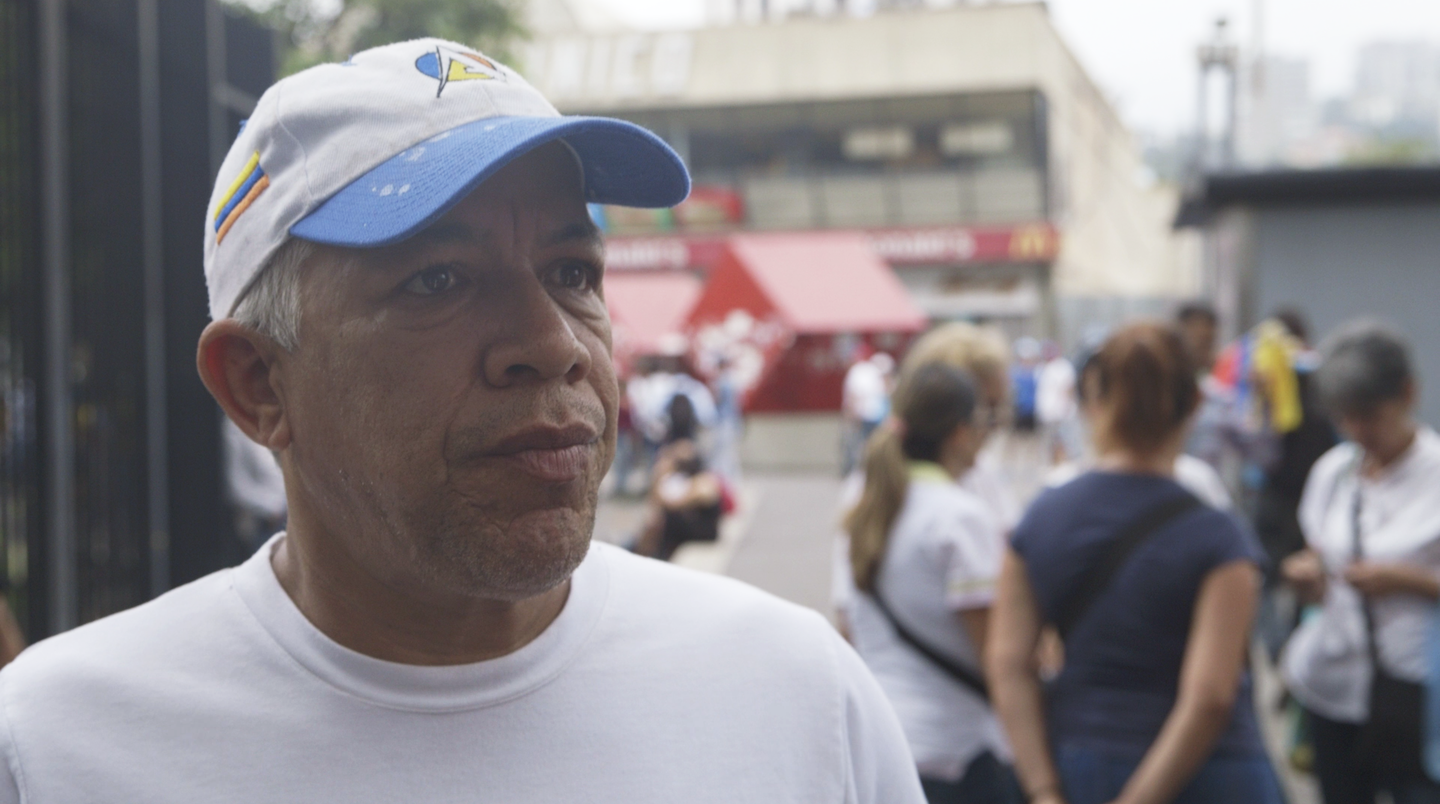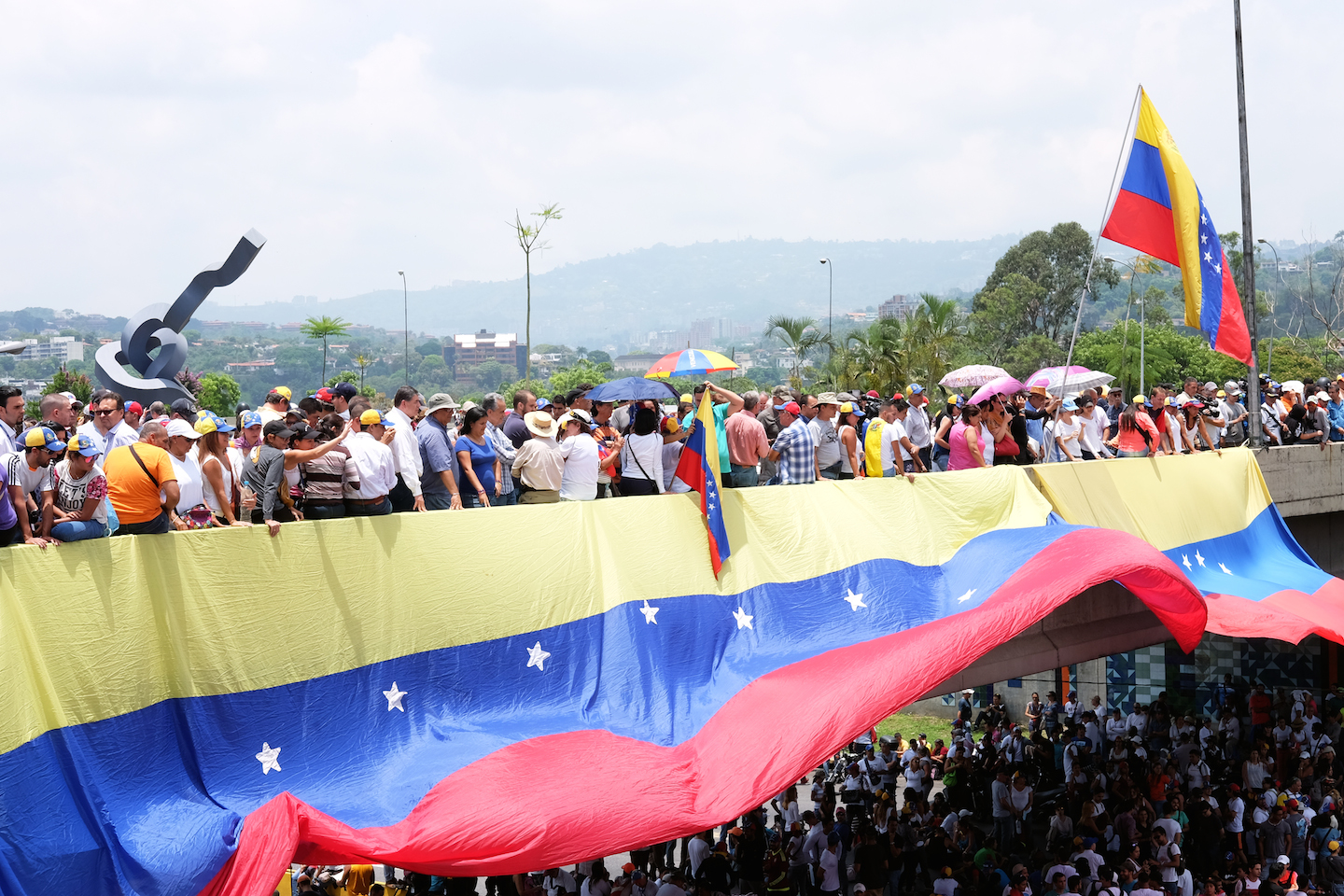CARACAS, Venezuela — Late in the morning on Monday, April 24, protesters gathered on a patch of grass next to a pedestrian bridge in Altamira, in the eastern and wealthier half of Caracas. They were planning the latest march in a series of protests against the government of President Nicolás Maduro that have rocked the faltering country since March 20, when Venezuela’s highest court attempted to dissolve the national assembly in an effort to further weaken Maduro’s opponents.Protestors like those gathered in Altamira have seized on Maduro’s latest show of autocracy and the country’s collapsing economy to mobilize a movement that now extends beyond the typically wealthy opposition leaders to those upon whose support Maduro and his United Socialist Party of Venezuela have long relied — the country’s poor.Alirio Maldonado, a local leader for a party called Avanzada Progresista, is among that cohort. He is a low-profile figure, but he represents, more than most other opposition leaders, the seismic shift currently taking place in Venezuela, and the reason Maduro might have something to fear. Unlike the majority of protesters in the streets that day, Maldonado hails from one of the poor neighborhoods in the hills of Western Caracas — 23 de Enero [January 23], or El 23 for short, a parish known as a bastion of support for the government, and the place where former President Hugo Chávez is buried.Maldonado was a fierce Chávez supporter and actively participated in the government’s efforts to uplift the slums of Caracas. But Maldonado, a stocky man with bright white hair, is now a diehard member of the opposition.“More and more people in El 23 are turning against Maduro,” Maldonado said. “Of course it’s changing. How are you not going to change when you don’t have access to food, when you don’t have access to medicine?”The loss of El 23 could very well signal the tipping point for Maduro, who despite feeling the pressure from the country’s upper and middle classes, has enjoyed robust support among the urban poor.
Unlike the majority of protesters in the streets that day, Maldonado hails from one of the poor neighborhoods in the hills of Western Caracas — 23 de Enero [January 23], or El 23 for short, a parish known as a bastion of support for the government, and the place where former President Hugo Chávez is buried.Maldonado was a fierce Chávez supporter and actively participated in the government’s efforts to uplift the slums of Caracas. But Maldonado, a stocky man with bright white hair, is now a diehard member of the opposition.“More and more people in El 23 are turning against Maduro,” Maldonado said. “Of course it’s changing. How are you not going to change when you don’t have access to food, when you don’t have access to medicine?”The loss of El 23 could very well signal the tipping point for Maduro, who despite feeling the pressure from the country’s upper and middle classes, has enjoyed robust support among the urban poor. The protests happening now across Venezuela feel fundamentally different from the last major wave of protests in 2014, which were largely confined to the wealthier sectors of Caracas and led by students at comparatively elite universities. This year the protests have been unprecedentedly large precisely because they have grown to include working class and poor citizens who were mostly absent three years ago.But where the government has repressed protesters in the East, sometimes with brutal force, the repression of unrest in the impoverished barrios has, by many accounts, been much worse.These neighborhoods are largely controlled by colectivos, or pro-government militias. Though police and military often use violence against protesters, colectivos do so without restraint and with total impunity — of the 26 deaths so far in protests this year, many have been blamed on this ersatz police force.On the night of April 19, residents of Antímano, another poor neighborhood in Western Caracas and a traditional Maduro stronghold, flooded the streets after the usual protesters had spent the day blocking intersections and highways in the East. According to a resident of the neighborhood, police, military, and colectivos showed up within minutes, firing their guns into the air. The next day, members of the Tupamaros — probably the most notorious and feared colectivo — were posted on every street corner, visibly armed.It’s not surprising that Maduro would respond to unrest in the lower classes with violence. It’s perhaps the ultimate sign that his abysmal record will soon bring his desperate grip on power to an end. Today, Maduro’s approval rating stands at 19 percent.For now, the opposition seems to be stoking the fire without a clear sense of what comes next. On Monday at Plaza Brión, I spoke to an adviser for Freddy Guevara, a figure rising quickly among the opposition, who told me they had heard reports that Maduro was said to be considering an olive branch of sorts: a schedule for elections this year.This has long been a principal demand of protesters, but it’s no longer enough — they won’t accept new elections unless major opposition figures who are currently jailed or barred from public office are allowed to run. Maduro, who still enjoys the military’s backing, is unlikely to offer such a concession, however.“In the meantime,” said Miguel Tinker Salas, a Venezuelan professor of history at Pomona College in California, “what the opposition wants to do is heat up the streets.”
The protests happening now across Venezuela feel fundamentally different from the last major wave of protests in 2014, which were largely confined to the wealthier sectors of Caracas and led by students at comparatively elite universities. This year the protests have been unprecedentedly large precisely because they have grown to include working class and poor citizens who were mostly absent three years ago.But where the government has repressed protesters in the East, sometimes with brutal force, the repression of unrest in the impoverished barrios has, by many accounts, been much worse.These neighborhoods are largely controlled by colectivos, or pro-government militias. Though police and military often use violence against protesters, colectivos do so without restraint and with total impunity — of the 26 deaths so far in protests this year, many have been blamed on this ersatz police force.On the night of April 19, residents of Antímano, another poor neighborhood in Western Caracas and a traditional Maduro stronghold, flooded the streets after the usual protesters had spent the day blocking intersections and highways in the East. According to a resident of the neighborhood, police, military, and colectivos showed up within minutes, firing their guns into the air. The next day, members of the Tupamaros — probably the most notorious and feared colectivo — were posted on every street corner, visibly armed.It’s not surprising that Maduro would respond to unrest in the lower classes with violence. It’s perhaps the ultimate sign that his abysmal record will soon bring his desperate grip on power to an end. Today, Maduro’s approval rating stands at 19 percent.For now, the opposition seems to be stoking the fire without a clear sense of what comes next. On Monday at Plaza Brión, I spoke to an adviser for Freddy Guevara, a figure rising quickly among the opposition, who told me they had heard reports that Maduro was said to be considering an olive branch of sorts: a schedule for elections this year.This has long been a principal demand of protesters, but it’s no longer enough — they won’t accept new elections unless major opposition figures who are currently jailed or barred from public office are allowed to run. Maduro, who still enjoys the military’s backing, is unlikely to offer such a concession, however.“In the meantime,” said Miguel Tinker Salas, a Venezuelan professor of history at Pomona College in California, “what the opposition wants to do is heat up the streets.”
Advertisement

Advertisement
Nearby at Plaza Brión, a number of opposition-aligned politicians and activists had gathered as the protests warmed up. They represented numerous small political parties representing different classes of wealth; together, they have very little in common other than their opposition to Maduro.This shared anger was quickly evident in a moment of commotion unfolding that morning: A man on a motorcycle had tried to steal someone’s phone, so protestors surrounded him, pulled him off the bike, and roughed him up. Beyond the dramatic food and medicine shortages, the clearest index of Venezuela’s economic crisis and social unraveling is the sharp rise in street crime. It’s one of the many things of which Venezuelans say they are cansados — sick and tired.There was talk of setting the man’s motorcycle on fire. “They should cut off his fingers,” a middle-aged man said calmly.In the latest sign of the country’s deepening crisis, Venezuela announced Wednesday it would leave the Organization of American States after facing criticism from the member organization.“How are you not going to change when you don’t have access to food, when you don’t have access to medicine?”

Advertisement